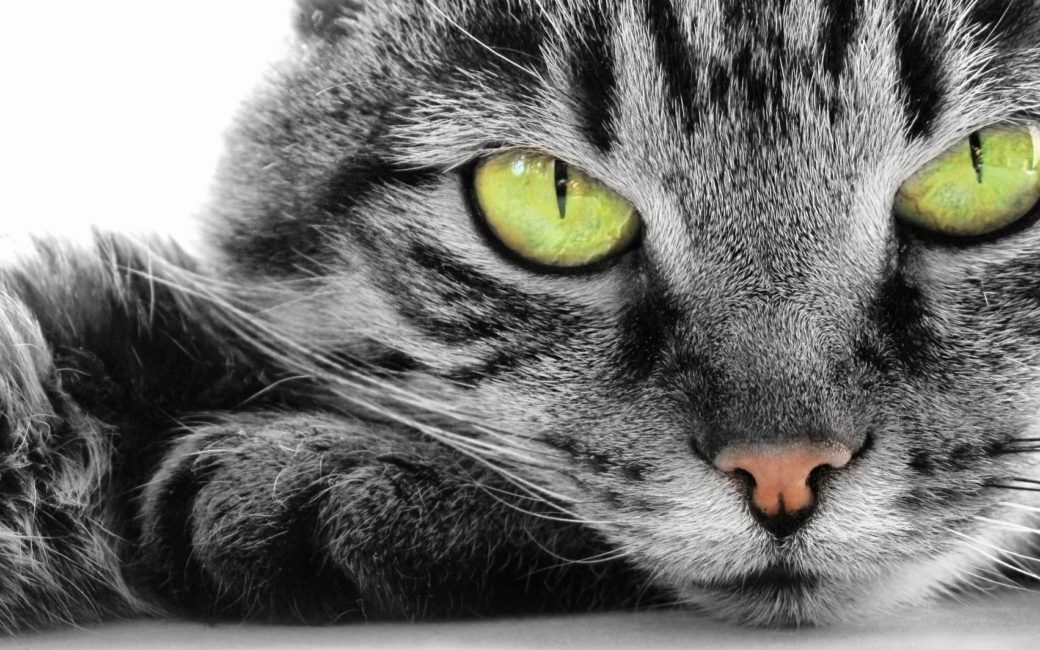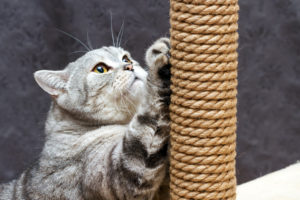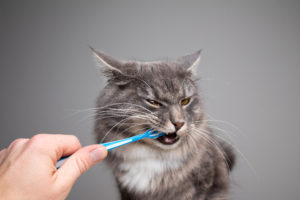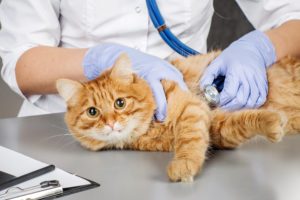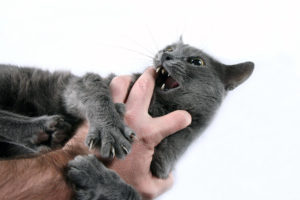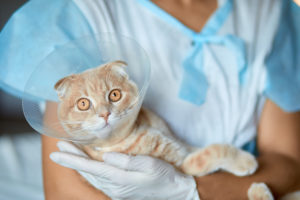HERE ARE THE TOP 7 THINGS ALL CAT OWNERS NEED TO KNOW TO GIVE THEIR CAT A LONG & HAPPY LIFE!
1) Cats Need Wet Food Now, For Fewer Problems Later:
The #1 cause of death in cats 5 years and older is DEHYDRATION-related illnesses, which lead to painful and sometimes fatal urinary tract infections, blockages, and kidney issues, both in males and females. Cats don’t have a strong thirst drive like dogs and humans and rarely drink enough water on their own (not even with those fancy cat fountains). Dry food is very far away from what a cat should actually eat as it is low in moisture at 10% (wet food is at 75%), 3 times higher in carbohydrates than wet food, and contain a lot more PLANT based proteins and cats are designed to consume animal based proteins! This is why it is vital for cats to have wet food given daily as it is closer to what they would eat in the wild. The best practice is to add a little water to the wet food to be sure they are taking in enough fluids to stay properly hydrated. This will help to avoid many life-threatening issues. After running my animal rescue, “Furry Nation Salvation”, for over 11 years, I have seen too many of our adopted felines develop serious issues and die from urinary blockages and kidney-related issues. All these cats were on dry food only, never getting canned wet food in their daily diets.
RECOMMENDED: Try to think of canned wet food as your cats MAIN source of diet, while dry food given as a treat. You can leave out dry food if this is your normal routine, but give your kitty at least half of a 5.5 oz. (or 1 full 3 oz. can) of wet food every single day. Add 1-3 tablespoons of water to it at every feeding. If you cat doesn’t notice, why not? We do encourage giving your cat wet food twice a day (Half of a 5.5 oz. can in the morning and the other half at night or 2 full 3oz. cans) as this will ensure your favorite feline is maintaining proper hydration. A full fresh bowl of water should always be available. To read more info on why wet food is so important, the cost involved, ways to feed multiple cats on a budget, and tricks if your cat doesn’t like wet food, click here.
2) How To Deal With Your Cat’s Claws & Scratching:
Kittens spend most of their first year exploring and jumping everywhere! Learning to cut your kittens or cat’s claws every two weeks (regular human nail clippers work great) will help dramatically while they are learning where and where not to exercise their scratching urges. Since they are instinctive scratchers, make sure to purchase a couple of different kinds of scratching posts – maybe a tall one (32” or taller) and another that lays flat on the floor. Try different materials such as sisal, wood, carpet or cardboard. Putting a little catnip on and around the scratching post will help attract them to it. To learn more about nail cutting click here.
3) Learn How To Take Care Of Your Cat’s Teeth:
You couldn’t imagine going 15 years without ever brushing your teeth but this is the case for most of our furry felines. By the time they are 3 years old, 70% of cats and 80% of dogs, have some form of dental disease. Dental care is the health area most overlooked by cat owners as people aren’t aware of how easy, affordable, and important it is for our pet’s overall well-being. In fact, a cat can live longer with proper oral care! Dental neglect frequently causes gingivitis, which can lead to serious dental issues, including plaque formation and the resulting bacteria spreading to the heart, liver and kidneys.
The idea that eating dry kibble will clean a cat’s teeth is a myth! This would be like thinking that eating pretzels would clean your own teeth. The carbohydrates in dry food actually promote the growth of tartar and plaque and do more harm than good. A yearly dental check-up by your vet is recommended, as well as starting a home routine to keep your pet’s mouth healthy. There are brushing and NO-brushing solutions, including enzymatic pet toothpaste and brushes made specifically for cats (my cat & dog love the poultry flavor), dental wipes, oral gels (no brushing required), dental treats, and liquid additives that you add to your pet’s water dish. Read this article to learn more information.
4) Know When To Call A Vet And Save For It:
Cats instinctively hide their pain. When they aren’t feeling well, they may hide or avoid interaction, become lethargic, or simply not act like themselves. Unusual aggression can also be seen. My father’s cat became increasing agitated and withdrawn. There was no visible problem, but a visit to the vet and lab work showed she had an infection in her leg. Other things to look out for: A change in your cat’s appetite, discolored or pale gums (they should be pink), walking abnormally, a change in litter box habits (frequent trips to the litter box, crying or straining once inside, or going outside of the litter box), frequent vomiting, blood in vomit, vomit accompanied by lethargy, or a prolonged cough. Just trust your instincts! You know your cat better than anyone else, so if something seems off, take your cat to the vet.
And since we’re on the subject, let’s be honest. Vet care can be expensive! Start the habit of putting money aside every month for emergency vet care. I cannot tell you how many people are unable to get their pet the medical care they need because they can’t afford the vet bill. If our pets get sick or injured, we are literally all that stands between life and death for them. Sadly, I have seen too many cases where, people feel they are forced to euthanize their beloved pet because they simply cannot afford proper treatment. We recommend putting at least $5 a week (more if you can afford it) into an emergency vet fund. Set up a coin jar in the kitchen and have your family members put every stray penny, nickel or dime in it – you’d be surprised how quickly this can add up! You can also plan ahead by enrolling in one of the numerous pet insurance plans that cost as little as $8 a month. Your pet relies on you for everything – don’t let him down in his time of need. Click here to see other resources for vet care. Click here to learn about common toxins to your cat and dog lurking right inside your home.
5) How To Discipline Your Cat The Right Way:
- Hitting your pet is never acceptable and will only make him confused and fearful of you. Pets do not associate pain with something they did wrong. Try other methods proven to work. When our kitten bites our hand, we start with a stern, “NO”, followed by blowing in his face. This will get him to stop the bad behavior. Remember to establish good play habits and never allow your hand to be used as a toy. If he is in a playful stage – grab a toy. You want to teach your cat that hands are for petting and toys are for playing. If your cat jumps on the counter, say “NO,” in a deep tone of voice, followed by spraying him with a squirt bottle filled with plain water. You can also use loud noises such as clapping your hands, shaking a jar of pennies, or making a PSSSFFFF sound. Any of these methods will discourage your cat’s bad behavior, whereas hitting, will only make your cat withdrawn and distrustful of you. Consistency & repetition are key. You must discipline your cat EVERY TIME he does something wrong. If you only discipline him some of the time, he won’t understand that what he is doing is wrong and will repeat the same bad behavior. To learn about all 7 methods to discipline your cat – including training devices that work, click here.
6)_How To Keep Your Cat Happy And Safe Indoors:
Cats who are allowed to roam freely outside may not survive to old age. Aside from the most obvious dangers of getting lost or hit by a car, cats can also fight with other animals and end up with serious wounds that require immediate veterinarian care. They are often killed by predators such as coyotes, snakes, raccoons, owls and hawks. Outdoor cats frequently develop tapeworms and heartworms from being bitten by fleas and mosquitos. Cats able to roam outdoors could also be picked up by animal control, mistreated by children or cruelly poisoned by neighbors who dislike cats in their yards. Growing up, we always had indoor/outdoor cats and NONE of them made it to old age. It’s a heartbreaking truth and I learned from my childhood. My cats, Solo & Obi-Wan, will never be allowed to step one paw outside – ever! Some people think its okay to let their cats explore outside as long as they are outdoors with them. This is a mistake because the cat will then lose its fear of the unfamiliar territory and this usually leads to future escape attempts if a door is left open by mistake. Try using scare tactics if necessary to get your cat fearful of the outdoors. Have a family member hide near the door making a loud and scary noise when your cat in nearby, use a loud horn or shake a jar of pennies, or use a water spray bottle when he comes too close to the door. We have coyotes in our area and these are the techniques we use if our cats show any interest in going outside. We have 4 kids so there are a lot of play dates at our home, with a lot of kids going in and out and doors being left open. At those times, we place our cats in the bathroom so we don’t have to worry about them slipping outside unnoticed. This is their “safe room” and is outfitted with everything they need to stay comfortable such as – food, water, cat box, scratching post, toys and cat beds.
7) Spay And Neuter Before 6 Months Old To Avoid Behavioral And Medical Problems:
By spaying and neutering your pet, you’ll help control the pet homelessness crisis, which results in millions of healthy cats and dogs being euthanized in the United States each year simply because there are not enough homes to go around. There are many behavioral and medical benefits to spaying and neutering your pets. Fixing your cat by 4-5 months of age ensures you won’t have any unwanted pregnancies and also eliminates the unpleasant behaviors that accompany sexual maturity, such as vocalizing, aggressiveness, spraying and urine marking, and roaming. Fixed cats are also at a reduced risk for mammary tumors and testicular cancer later on in life and live an average of 40% longer than unfixed cats. Female cats also won’t be at risk of potentially fatal infections such as Pyometra, which can affect 25% of unfixed cats before the age of 10. Pyometra is an infection of the uterus and may appear as if the animal is pregnant or gaining weight, however, the cat’s uterus is filling with pus. This is life threatening condition which needs immediate vet care. Fixing before the kitten goes into their first heat (6 months) is ideal. If you’re located in Florida, check out our list here of discount spay and neuter locations. Otherwise, contact your local shelter or rescue group for discounted clinics in your area.

